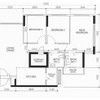HOW TO CHOOSE THE RIGHT COUNTERTOP THICKNESS FOR YOUR HOME.
Stone suppliers in Singapore carry a wide range of kitchen tops. From natural stone like granite, marble and sandstone to solid surface kitchen tops and engineered quartz stone, each type of stone has its advantages and disadvantages depending on the desired aesthetic tastes and functionality. So how do you choose the right thickness for your countertop? There are several types of kitchen countertop stones which have their own physical characteristics. Depending on each homeowner’s individual lifestyle and expectations, different types of stone would work best. Today, we’ll take a look at the different thicknesses of countertops in production, their advantages and disadvantages. 10-13MM, OR ABOUT 1/2 INCH COUNTERTOPS. One of the first questions you’ll be asked by a stone supplier is the thickness you want. While thicker stones are preferred for their dramatic but minimalist look especially for natural stone or quartz, thin countertops have several advantages that any smart homeowner should consider carefully. THINNER AND LIGHTER. The biggest advantage that thin, 10-13mm countertops provide is lightness. Gravity does nasty things to a heavy slab that’s hanging off a surface, and trying to fasten it vertically would be a technical impossibility without special support systems in place. In many applications where the slabs hang freely and unsupported, excessive weight would jeopardize the structural integrity of the piece if special load-bearing or anchoring system is not in place. They are also much easier to work with and handle and do not require eight people just to move a slab from the ground floor up to your place. Stone Italiana Quartz carries exceptional 13mm quartz kitchen tops in three types of finishes; polished, rock face and grain. FLOATING COUNTERS, WATERFALL EDGES AND MORE. Thin countertops are a lot lighter than thick slabs, which makes it possible to build special applications. These include vertical surfaces such as feature walls, fuller backsplashes and waterfall edges. The sides of a kitchen island is a good example where waterfall edges have a nice touch. Thin slabs also make it possible to build floating counters where they are minimally supported by a foundation. Thin and light countertop slabs are also easier to cut and shape, which lends its suitability to integration work such as installation of a kitchen sink. If necessary, thin slabs can be laminated around a lightweight core material such as wood. This makes the countertop thicker without adding too much weight. 20-30MM, 1 TO 1 ¼ THICK COUNTERTOPS. MORE DURABLE Although heavier, more expensive and less versatile, thicker countertops are more durable than lighter ones; 30mm slabs are less prone to breaking compared to 20mm slabs, which in turn are more durable than 13mm ones. Countertops come in slabs as thick as 40mm or 60mm, but are often too expensive and too heavy for most homes to support. Soft stone such as marble and sandstone benefit significantly from the extra thickness. BUILT TO LAST AND CARRY HEAVIER LOADS. Thick kitchen top stones also last longer, which makes up for the difficult installation and high initial cost. Thick slabs of high-quality stone, especially when well-installed, also bring with it a nice hike in equity value, which alone is enough reason for stone suppliers in Singapore to recommend them. Thicker slabs are also best suited whenever high traffic/usage is expected, and a special emphasis on durability is required; e.g. kitchen tables, bathroom vanities, grilling stations (hard, natural stone like granite provide the best heat resistance), shower seats, decorative cutting boards and coffee tables. MORE KITCHEN TOP EDGE PROFILING OPTIONS. In addition, the extra material provided by thicker countertops gives homeowners more options for kitchen top edge profiling and fashions. You cannot cut deep curves into thin laminated countertops without biting into the laminated core. Edge profiles aren’t just for aesthetic purposes. For safety reasons, many interior designers and home owners opt for the bullnose edge profile, which is not something you want to accidentally hit.



Courtney Allan
Related Discussions
Help with an open plan kitchen, dining and living area...
Q
HELP: Small L-shaped kitchen with refuse chute on wall!
Q
Mixing Singaporean style with Scandinavian - how!?
Q
Must Know About Integrated Sink
Q